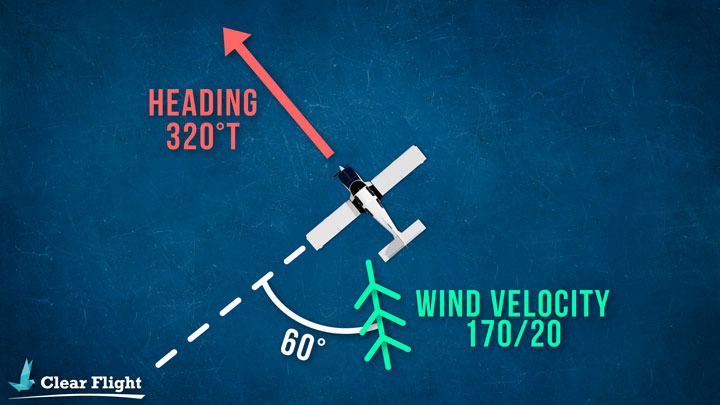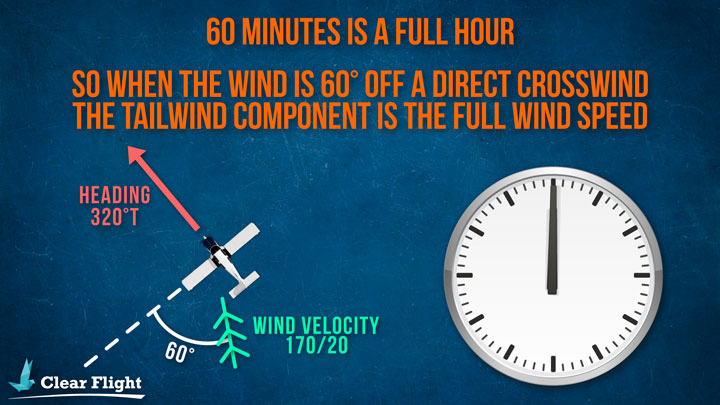Calculating Crosswinds & Headwinds
When the wind is at an angle (other than 90°) to the aircraft’s heading, there will be both a headwind/tailwind component and a crosswind component. We can use something known as the ‘clock code‘ to help with this. In this guide, we’ll use examples to explain how to:
1. Calculating Your Crosswind
You are taking off from runway 09 and the surface wind is 045° at 20 knots. What will the crosswind be for your departure and is it below your aircraft’s maximum demonstrated crosswind component of 15 knots?
1 First, find the angle between the wind and your heading
In this case, the wind is 45° left of your nose.
2 Next, use the ‘clock code’. Take this number of degrees and think of it as minutes on a clock:
Today, the wind is 45° left of your nose, so the crosswind is ¾ of the wind strength.
3 In this case, the wind strength is 20 knots so the crosswind component is 15 knots
The crosswind for your departure will be 15 knots – equal to this aircraft’s maximum demonstrated crosswind component.
2. Calculating Your Drift Angle
The clock code can also be used to calculate your drift (i.e. how far you will be blown ‘off course’ by the wind). Let’s use the same example to see how the clock code can be used to calculate the drift:
After taking off from runway 09, you will be flying on a heading of 090° with a true airspeed (TAS) of 90 knots. The wind is 045/20. What drift will you experience?
2 Next, determine the max drift for this TAS and wind speed
See our article on Maximum Drift for more information on this


3 Again, use the clock code to determine how much of the max drift needs to be applied
Today, the wind is 45° off your heading. 45 is ¾ of an hour so your drift will be ¾ of the max drift:
Max Drift = 13°
Drift Experienced = ¾ of 13° = 10° (approx.)
3. Calculating Your Headwind or Tailwind
Your headwind or tailwind can also be calculated with the clock code. This can then be used to work out your ground speed by adding or subtracting the headwind or tailwind from your true airspeed.
If the wind is directly on your nose or tail, the headwind/tailwind component will be the full wind speed.
If the wind is 90° to your nose, it will be all crosswind and our groundspeed will not change.
For any angle in between, the ‘clock code’ method can be used. However, this time we need to see how far the angle differs from a direct crosswind. Let’s look at an example:
You are flying on a heading of 320° with a true airspeed (TAS) of 90 knots. The wind is 170/20. What is your groundspeed?
1 Calculate the shortest angle between a direct crosswind and the actual wind:
Your heading is 320° so a direct crosswind would be 230° (320° – 90°)
The angle between 230° (a direct crosswind) and 170° is 60°
2 Use the clock code to determine how much of the wind is headwind or tailwind
The wind is 60° off a direct crosswind, so the headwind/tailwind component is the full 20 knot wind speed.
From the diagram, we can see the wind is coming from behind the aircraft, so we have a 20 knot tailwind.
3 Add the tailwind to or subtract the headwind from the true airspeed (TAS) to get the groundspeed
TAS = 90 knots
Tailwind = 20 knots
Groundspeed = 90 + 20 = 110 knots
Interested in other rules of thumb like the clock code? Check out Skybrary’s article on aviation Rules of Thumb: https://skybrary.aero/articles/rules-thumb







